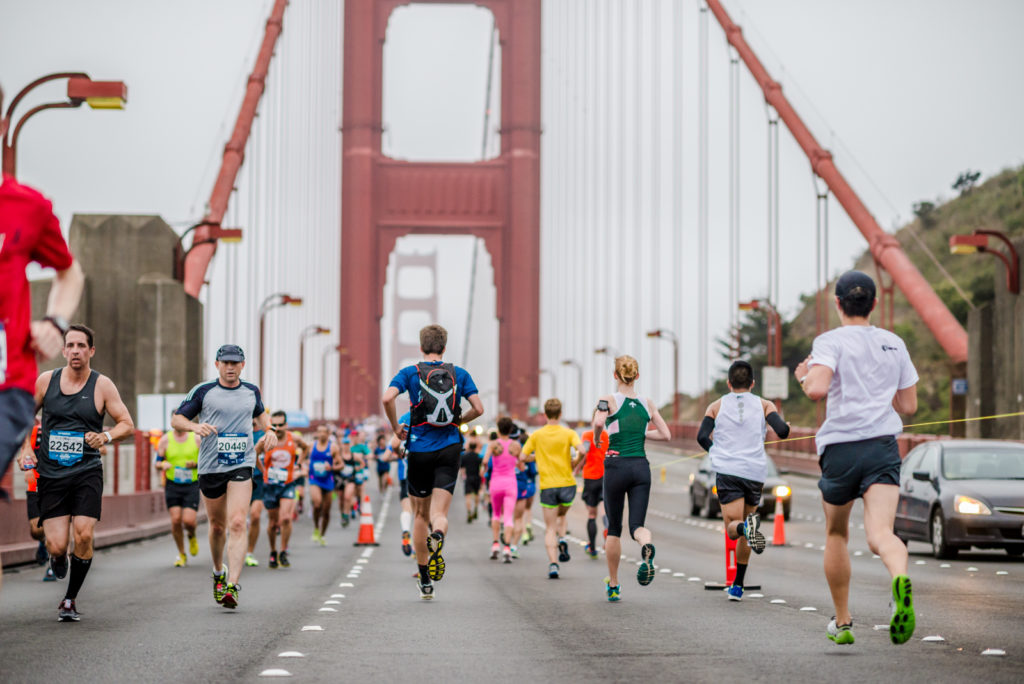Final Month of Training for TSFM
Contributed by Erin Garvey, a 2017 Ambassador for The Biofreeze San Francisco Marathon.
Take a deep breath. You have T minus 1-month (or actually, less than one month!) to go until you run one of the sold-out San Francisco Marathon events: the Full Marathon, one of the Half Marathons, the 5K or the Ultramarathon. Most of your hardest training is now behind you. You’ve been working your tail off for the past number of weeks – months, in reality – and Race Day is inching ever closer.

Are you freaking out yet?!
A lot of times, as Race Day approaches and runners begin their taper in earnest, many of us will begin to have what we affectionately or disparagingly call “taper crazies.” Suddenly, we begin to doubt that we’ve done enough work, that we haven’t put in as many miles as we should have or as much strength work that was prescribed, and we wonder how in the world we’ll be able to cover 52.4, 26.2, 13.1, or 3.1 miles.
What the heck were we thinking when we signed up for this race? We’re paying to do this?
Relax.
Breathe deeply and smile.
The anxiety that you may be feeling, the lack of confidence, the wondering if you’ve done enough or if you could have prepared differently – it’s all normal. It’s part of the endurance event training process, and I don’t think it matters if you’ve done 100 of these events or if the 2017 running of The Biofreeze San Francisco Marathon and its events will be your first go at this rodeo.
We all have nerves about this stuff; it’s good. It means we care.
During the last month/less-than-a-month until Race Day, your emphasis and priorities will likely shift from stressing your body to the max, getting in all your prescribed miles, strength work, and ancillary stuff, to straight up recovery and rejuvenation. Aside from a few periodic workouts that you may still have left, chances are high that most of your miles from here on out will be pretty comfortably paced and light in stress. There’s a reason for this: in the final 25 days (plus or minus) before your race, you want to get your body as fresh – as springy, as bouncy, as “good feeling” – as possible, so that when you toe the line, both your mind and body are ready to rumble.
Below, I’ll describe some tips and guidelines to help get you through your final month of TSFM training so you come out unscathed and ecstatic to race.

Revel in your accomplishment. Registering for an endurance event, and then training for one, are inherently different beasts. Lots of people sign up for races, but many never bother to train and thus, don’t show up at the starting line. The fact that you’ve both registered and trained, and are essentially putting the “final touches” on your training, is laudable. Give yourself a pat on the back or a big ol’ KUDOS for committing yourself to a goal for the past number of weeks or months. This training stuff isn’t for the faint of heart. Your tenacity is impressive, and no doubt your enthusiasm and dedication to your goals is pretty damn awesome, too.
Don’t sweat the small stuff. You may be freaking out about some runs that you missed for whatever reason: sickness, family or work conflicts, an injury flare, laziness, or whatever , and you may become inadvertently fixated on all the stuff you didn’t do. Change your tune, friend. Instead of thinking about everything you didn’t do, think about everything you did do. Even professional runners have to miss runs every now and then for one reason or another. Provided you did most of your runs as prescribed, you can safely go into Race Weekend knowing that you’re ready to get yourself across the start line and to the finish line safely and in one piece. (Disclaimer: of course, if you have any questions about your training or if it’s a safe idea to race, do not hesitate to talk to your coach.)
Reflect on your training log. Closely related to my above two points, reflecting on your training at the end of your program is important. It’ll allow you to identify any trends, ones problematic or encouraging , and it can help guide you in subsequent training sessions for future races. You may decide to do this after you run TSFM, but it can also be a good confidence boost to do this beforehand because you can see it all for yourself, all laid out in black and white, the tons of work you completed in order to prepare sufficiently to run the streets of San Francisco fast and well. Ask yourself what goals you set when you began this process weeks and months ago. How did you feel before you began? What has changed for you in the past few months, and what has stayed the same? The more you ask, the more you learn, so get on with interviewing yourself.
Sleep: It’s huge. It matters. Get some. Get more. Hopefully you haven’t underestimated the importance of sleep during your training, but if you have, it’s not too late. Prioritize sleep during your tapering period because doing so will allow your body to continue to reap the benefits of all your hard work. If you can, consider going to bed each night a little earlier than usual, because even just 10-15 more minutes each night can add up over these final 25 or so days.

Be kind to your body. While you may feel like you should hit some sort of arbitrary “racing weight,” remember that it’s more important that you continue to be kind to your body and cognizant of how you treat it during this final month. Be mindful of what you are (or aren’t) eating and drinking. I’m a proponent of consuming everything in moderation and for not taking yourself too seriously. Remember: this race is supposed to be fun! If you want a piece of cake at your child’s 3rd birthday party, but the race is two weeks away, eat the damn cake without feeling guilty about it. Your race-week nutrition needs may change, particularly if you choose to carbohydrate-load, but in the lead-up to race week, continue to eat as you normally would. You may feel like you’re gaining a little weight, which makes sense since you likely won’t be running the same high volume mileage that you were during your peak training period. Don’t let it get to your head; you’ll be fine. If you have any doubt, talk to your coach or to a certified sports nutrition dietitian.
Relax and unwind as much as you can. It’s fairly normal for endurance runners to get a little anxious during their final days before their race, so it’ll behoove you to do what you can to relax. Get to bed a little earlier each night, read a good book, or listen to soothing music, for example. If you regularly practice yoga, a light and gentle routine may do the trick; however, I’d urge caution if you haven’t practiced it regularly because you should really try to abstain from doing tons of new stuff during your taper (in the interest of letting your body fully recover and recharge).
Get all your Race Day stuff in order, and try it out, if you haven’t already. It’ll be really important that you know what you’re wearing on Race Day, and what you’ll be consuming if you’re planning to take in any additional nutrition from gels or drinks, so take these last few weeks to get all of your affairs in order. Make sure that the clothing options you have (plans A, B, and C to accommodate for potential weather scenarios) fit comfortably and don’t chafe, and that the shoes you have are in race-ready condition. So many runners have been burned by trying something new on race day. Nothing new on race day is the way to go, I promise.
Finalize your weekend plans for TSFM. Before long, race week will be here, so consider taking some time in the last few weeks before the race to finalize your race weekend details. Are your travel accommodations solidified? What’s your expo plan? Do you have your dinner arrangements handled? Though tedious, making sure all your Ts are crossed and your Is dotted can help alleviate any stress you may otherwise feel during the lead-up to the race, particularly during race weekend. (Official Ambassadors of The San Francisco Marathon, include myself, will be at the expo on both Friday and Saturday. We will also be leading a free shakeout run on Saturday morning from Fort Mason, the site of the expo, before opening hours. Come stop by, say hi, and get some free hugs and high-fives!)
Training for an endurance event can be such a life-altering, challenging, and fun activity, and I sincerely hope you’ve had a great ride on this rollercoaster thus far. The other Ambassadors and I are so excited to meet you at the expo and on the streets of our favorite city, and we can’t wait to dominate this race alongside you.
If nothing else: remember that you’ve already completed an impressively awesome accomplishment by the sheer virtue of getting through your training, so when things get tough on Race Day – and they probably will at some point – ride out the discomfort and know that you are ready to roll.
You’ve prepared for hours, days, weeks, and months for this moment. Smile through the discomfort, and then smile even bigger when you see that beautiful finish line await you.
You’ve totally got this. Virtual fist bumps, my friend!


